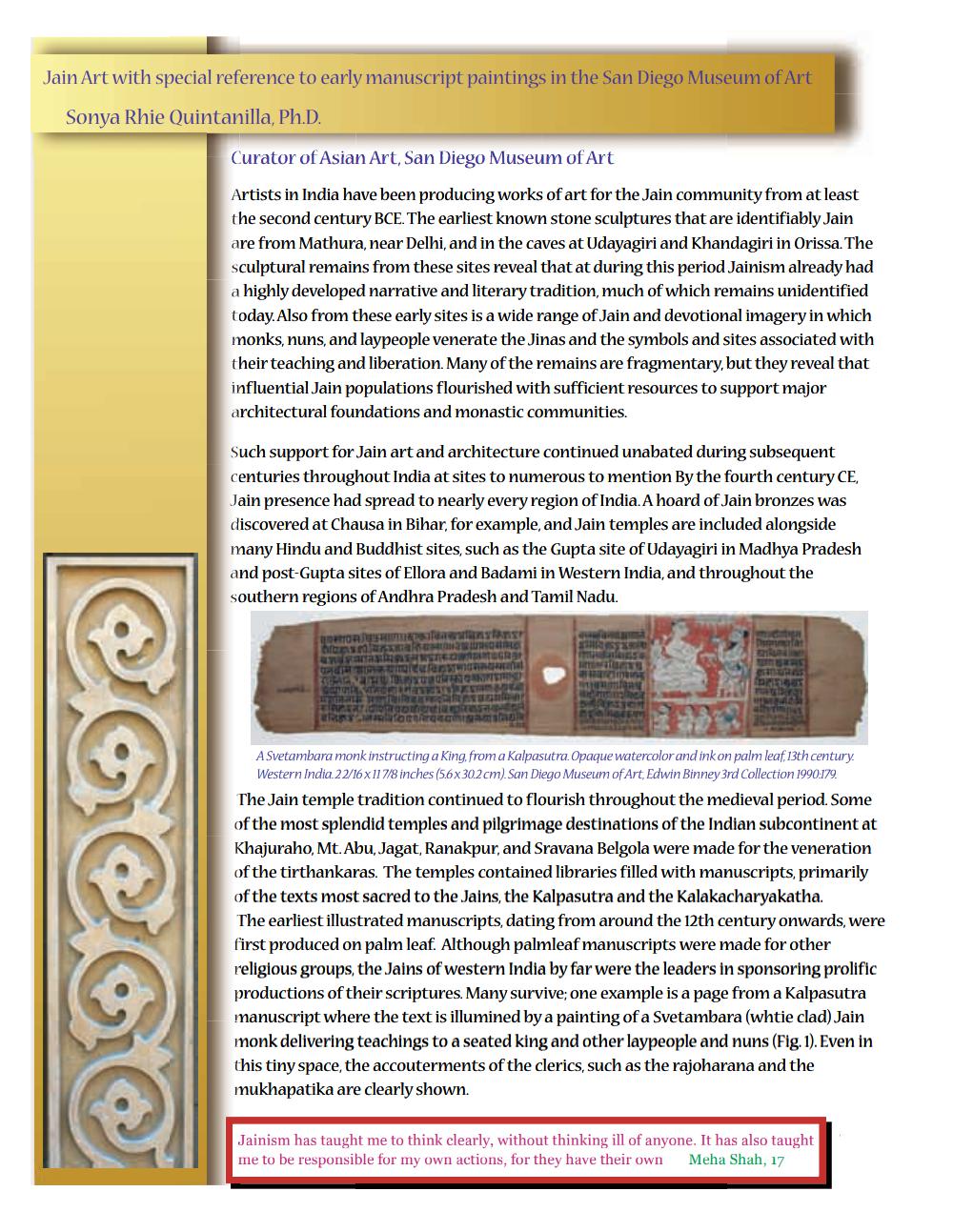________________
Jain Art with special reference to early manuscript paintings in the San Diego Museum of Art
Sonya Rhie Quintanilla, Ph.D.
Curator of Asian Art, San Diego Museum of Art
Artists in India have been producing works of art for the Jain community from at least the second century BCE. The earliest known stone sculptures that are identifiably Jain are from Mathura, near Delhi, and in the caves at Udayagiri and Khandagiri in Orissa. The sculptural remains from these sites reveal that at during this period Jainism already had a highly developed narrative and literary tradition, much of which remains unidentified today. Also from these early sites is a wide range of Jain and devotional imagery in which monks, nuns, and laypeople venerate the Jinas and the symbols and sites associated with their teaching and liberation. Many of the remains are fragmentary, but they reveal that influential Jain populations flourished with sufficient resources to support major architectural foundations and monastic communities.
Such support for Jain art and architecture continued unabated during subsequent centuries throughout India at sites to numerous to mention By the fourth century CE, Jain presence had spread to nearly every region of India. A hoard of Jain bronzes was discovered at Chausa in Bihar, for example, and Jain temples are included alongside many Hindu and Buddhist sites, such as the Gupta site of Udayagiri in Madhya Pradesh and post-Gupta sites of Ellora and Badami in Western India, and throughout the southern regions of Andhra Pradesh and Tamil Nadu.
bigse www.panasing KUPAL NEUT
gafaaetansta
NOWLE
A Svetambara monk instructing a King, from a Kalpasutra. Opaque watercolor and ink on palm leaf. 13th century. Western India. 22/16x117/8 inches (5.6x30.2 cm). San Diego Museum of Art, Edwin Binney 3rd Collection 1990:179. The Jain temple tradition continued to flourish throughout the medieval period. Some of the most splendid temples and pilgrimage destinations of the Indian subcontinent at Khajuraho, Mt. Abu, Jagat, Ranakpur, and Sravana Belgola were made for the veneration of the tirthankaras. The temples contained libraries filled with manuscripts, primarily of the texts most sacred to the Jains, the Kalpasutra and the Kalakacharyakatha. The earliest illustrated manuscripts, dating from around the 12th century onwards, were first produced on palm leaf. Although palmleaf manuscripts were made for other religious groups, the Jains of western India by far were the leaders in sponsoring prolific productions of their scriptures. Many survive; one example is a page from a Kalpasutra manuscript where the text is illumined by a painting of a Svetambara (whtie clad) Jain monk delivering teachings to a seated king and other laypeople and nuns (Fig. 1). Even in this tiny space, the accouterments of the clerics, such as the rajoharana and the mukhapatika are clearly shown.
Jainism has taught me to think clearly, without thinking ill of anyone. It has also taught me to be responsible for my own actions, for they have their own Meha Shah, 17




